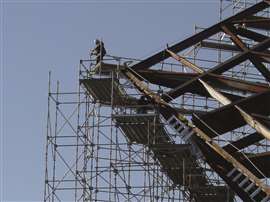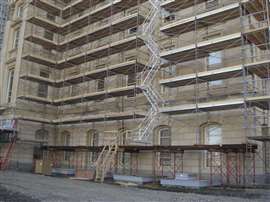Where’s the bracing?
12 September 2023
Brace yourself for this: Scaffolds need bracing. For whatever reasons, there has been, and continues to be, too much misinformation regarding supported scaffold bracing.
 For frame scaffolds, the frame provides bracing in one direction and cross braces, or other bracing, provides the bracing in the other direction. (Photo: David Glabe)
For frame scaffolds, the frame provides bracing in one direction and cross braces, or other bracing, provides the bracing in the other direction. (Photo: David Glabe)
Fabricated Welded Frame Scaffolding and System Scaffolding are the focus of this discussion. Obviously, the bracing for each type is not the same; cross-braces are used on frame scaffold while diagonal bracing is used on system scaffold. However, the purpose of the bracing is the same for each scaffold type, that is, the bracing provides strength and stability. The importance of bracing is recognized by the OSHA regulations and industry standards and codes.
Keeping in mind that the OSHA regulations are not instructions, and contrary to what some people think, the applicable regulations require adequate bracing, but do not describe what that bracing is.
There is good reason for that approach since there are alternative means for adequate bracing. OSHA succinctly requires, at 29 CFR 1926.451(c)(3), that: “Supported scaffold poles, legs, posts, frames, and uprights shall be plumb and braced to prevent swaying and displacement.” It’s a beautiful regulation, if such a thing exists. It gives the qualified designer plenty of options for bracing.
 The first rule of bracing is: Every scaffold leg must be braced in both directions to at least one other leg. (Photo: David Glabe)
The first rule of bracing is: Every scaffold leg must be braced in both directions to at least one other leg. (Photo: David Glabe)
Additionally, OSHA has a specific regulation, at 29 CFR 1926.452(c)(2), that addresses frame scaffolds. It requires that the cross braces “will automatically square and align vertical members so that the erected scaffold is always plumb, level, and square.” Note that this regulation only specifies what the cross braces will do, not how many are required to do it. It is up to the qualified designer to make that determination.
OSHA has no specific bracing regulations for system scaffolds, but the American National Standards Institute, ANSI, does. ANSI A10.8 requires, at 9.5, that: Each erected system scaffold shall be braced with vertical, horizontal, or diagonal braces or a combination thereof so that the erected scaffold is always plumb, level and square.” As with Frame scaffolding, this standard does not specify where and when the bracing is installed, again giving the qualified designer plenty of options for bracing.
So far in this article, it has been established that scaffolds need to be braced, it has been established that there are regulations that require bracing, and it has been established that qualified designers have options regarding the installation of bracing. Knowing this, what are the ramifications?
First, the scaffold designer must be knowledgeable about bracing. Second, erectors must follow the designer’s design. Third, the inspector must know what the designer designed, fourth, project safety personnel must either be knowledgeable about bracing or rely on the qualified designer’s design, and fifth, OSHA compliance officers must have the training to determine if the designer is qualified.
 (Photo: David Glabe)
(Photo: David Glabe)
Experience indicates that many scaffold designers are not qualified, at least not in the installation of adequate bracing. Experience also indicates that many erectors falsely believe they are qualified bracing designers. Furthermore, experience indicates that OSHA compliance officers are inadequately trained to correctly evaluate the adequacy of bracing. I suppose that can be a good thing for the unqualified designer or erector since inadequate bracing will be missed by the compliance officer.
What is correct bracing, you may ask. The answer to that is beyond the scope of this article. Despite that, here are several fundamental aspects of bracing that will help determine your level of understanding regarding scaffold bracing.
Scaffolds are three dimensional structures, meaning that scaffold legs require bracing in both directions, right to left, and back to front.
Bracing must be installed in compliance with manufacturers’ specifications.
The first rule of bracing is: Every scaffold leg must be braced in both directions to at least one other leg. For frame scaffolds, the frame provides bracing in one direction and cross braces, or other bracing, provides the bracing in the other direction. For system scaffolds, vertical diagonal bracing is required in both directions.
To comply with the first rule of bracing, end bays of scaffolds must have bracing.
- Horizontal diagonal bracing, or a suitable substitute, is required at each tie level.
- Bracing affects the unbraced length of the leg which affects the leg load capacity.
- Leaving out the cross braces on the inside face of a frame scaffold, for example a West Coast Plasterers’ scaffold, drastically reduces the frame leg allowable load capacity.
- Installing horizontal braces (goosers) at the top of each frame in place of cross braces considerably reduces the frame leg allowable load capacity.
- It is acceptable to install cross braces in every other bay if the manufacturer allows it.
- Cross braces must be installed on the studs. Wiring the cross brace to the frame leg is useless. Wiring the brace so it stays on the stud is okay.
- A 4-leg system scaffold tower must have diagonal bracing on all four sides.
- System scaffolds require diagonal vertical bracing at least every third bay unless the manufacturer allows longer spacing, which some manufacturers do.
- System scaffold runs require transverse bracing at least every third bay unless your manufacturer says otherwise.
- System scaffold diagonal bracing, both transverse and longitudinal, is required for the full height of the scaffold.
- Diagonal bracing must be attached to the same connection point to which the horizontal bearers and runners are attached. Some manufacturers and qualified designers will allow the diagonal bracing to be attached to the first connection point above or below the connection point where the runners and bearers are attached.
- Random installation of diagonal bracing is an indicator that the designer and erector are not qualified.
- If the scaffold inspector accepts scaffolds that do not meet the requirements of the first rule of bracing, the inspector is not a competent person. Find a different inspector.
- If the scaffold inspector accepts random bracing, get a different inspector.
- Wall ties, that is the device connecting a scaffold to the adjacent structure, does not substitute for bracing. The ties are there to keep the properly braced scaffold from falling over. The braces help keep the scaffold from collapsing.
Look at the photos here. Do these scaffolds meet the expected bracing requirements? If you don’t know, don’t design any supported scaffold until you do.
STAY CONNECTED



Receive the information you need when you need it through our world-leading magazines, newsletters and daily briefings.
CONNECT WITH THE TEAM








